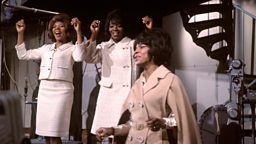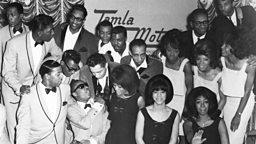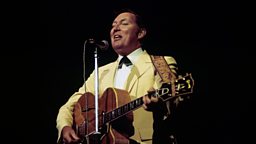From talent-spotting to comeback tours: How the music business really works
16 January 2018
A host of industry insiders reveal their secrets in new BBC Four series Hits, Hype & Hustle: An Insider's Guide to the Music Business. From the agents who spot the superstars of tomorrow, to the veterans tempted back on the road for one last paycheck, ALASTAIR McKAY takes a look.

Wilko Johnson, the former guitarist with Dr Feelgood, tells a good story about watching Bill Haley at a rock’n’roll revival festival at Wembley Stadium in 1972.
Haley was never particularly fashionable, and though rock’n’roll was enjoying a revival of sorts in the early 1970s, there was no reason to suspect that his band, the Comets, would have much to offer, some 19 years after scoring a hit with Rock Around the Clock.
In the age of streaming, it’s harder for musicians to make a living from selling their music
And yet, says Johnson, his eyes boggling at the memory, “they rocked like a pig”.
Johnson relates that tale in the final instalment of Hits, Hype and Hustle, a three-part documentary which aims to throw light on the more functional side of the music business.
The third part, presented by PR man Alan Edwards, is about revivals and reunions, a growth area these days, operating almost without discrimination.
Amongst others, Edwards discusses the return of The Ruts (whose singer Malcolm Owen died in 1980, while drummer Dave Ruffy boasts of having a hip replacement), Blondie (Debbie Harry is tired of Hangin’ on the Telephone), the Police (drummer Stewart Copeland required “band therapy” to cope with the demands of singer “Stingo”) and Altered Images, whose singer Clare Grogan observes that the 1980s revival has now been going on longer than the decade itself.
Andy McCluskey and Paul Humphreys of the futuristic synth-band OMD are also on hand, sounding a little like characters from Last of the Summer Wine as they discuss the telephone booth which inspired their 1980 single, Red Frame, White Light. The band had no phone, so they used the kiosk as an office. Nothing, it seems, dates like the future.
So is it all over for the music business? True, in the age of streaming, it’s harder for musicians to make a living from selling their music, so much of the financial effort has migrated to the live arena, where established acts have worked out that ticket prices are elastic.
In the second of these documentaries, Metallica’s manager Peter Mensch observes: “We did some tests in the last couple of years when we realised that the prices for Metallica tickets could be much higher than it used to be, and we changed it, and there was no audience pushback... shows that might have made X, now made 3X.”

Certainly, this is a far cry from 1965, when it was possible to see the Motown Revue show featuring Martha and the Vandellas, Smokey Robinson and the Miracles, Little Stevie Wonder, and The Supremes for a top ticket price of 17 shillings and sixpence (87 and a half pence in decimal money).
Of course, that tour wasn’t a sell-out because it was relatively expensive. In 1965, you could see the Rolling Stones for 12/6 (62 and a half pence). The Motown acts toured the UK in a coach, and were startled by the spring weather.
People will always make music, and people will always make money from that music
“I remember waking up with my boots on,” Martha Reeves recalls, “and I’d run out of shillings for the heater. You had to put shillings in the heater or you froze to death... and my song was Heatwave.”
Reeves’ anecdote reveals a broader truth about the music business. The music and the business may need each other, but they’ve always had a somewhat abusive relationship.
People will always make music, and people will always make money from that music. Sometimes the people making the money will be the musicians.
But while technology has done much to change the way the business is done, there is surprising degree of continuity between then and now.
The first of the three shows, hosted by music agent Emma Banks (who has worked with Katy Perry and Kanye West), concentrates on the blunt end of the business - finding the talent, and selling it.
Banks cites “the master”, veteran music executive Clive Davis, who discovered Whitney Houston. Unsurprisingly, she concludes that there is no magic formula for success, citing Davis’s belief that the key is finding the right song for the right artist.
Davis waited two years before he was able to pair Whitney Houston with I Wanna Dance with Somebody. Today, that process would be aided by statistical analysis of streaming data and promotion on social media, but there are no guarantees.
The rewards, when it works, are eternal. PR Alan Edwards reveals that his latest client is the hologram of Roy Orbison. For everyone else, as John Niven (the A&R man who chronicled the excesses of the 1990s in the Britpop novel Kill Your Friends) notes, the enduring image of the music business can be found in a 1984 Kit-Kat commercial, where actor Gavin Richards tells a New Romantic band: “You can’t sing. You can’t play. You look awful... you’ll go a long way.”


Watch the series
-
![]()
Hits, Hype & Hustle: An Insider's Guide to the Music Business
Friday 19 January, 21:00, BBC Four
Watch clips
The presenters



More from BBC Arts
-
![]()
Picasso’s ex-factor
Who are the six women who shaped his life and work?
-
![]()
Quiz: Picasso or pixel?
Can you separate the AI fakes from genuine paintings by Pablo Picasso?
-
![]()
Frida: Fiery, fierce and passionate
The extraordinary life of Mexican artist Frida Kahlo, in her own words
-
![]()
Proms 2023: The best bits
From Yuja Wang to Northern Soul, handpicked stand-out moments from this year's Proms












